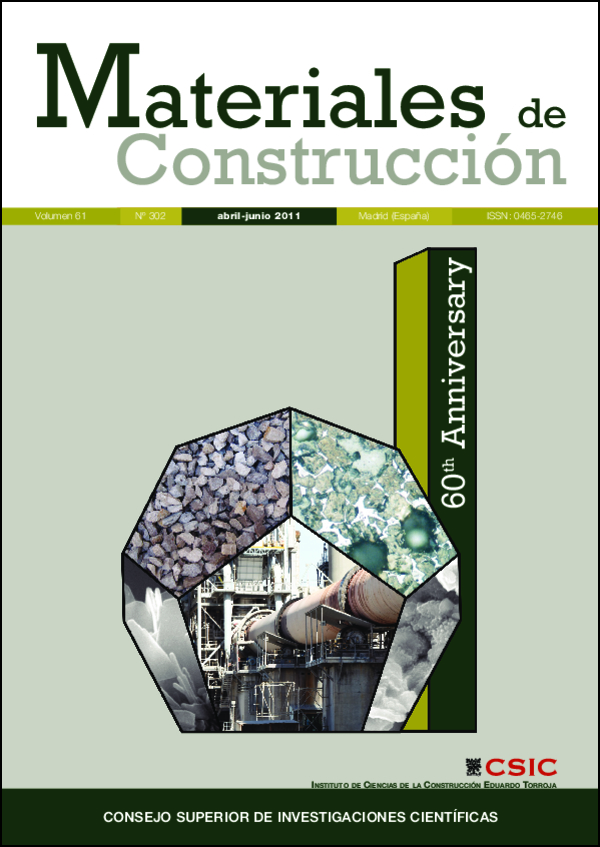Pozzolanic evaluation of the sugar cane leaf
DOI:
https://doi.org/10.3989/mc.2011.54809Keywords:
pozzolan, Portland cement, amorphous material, calcium hydroxide, mortarAbstract
This paper presents the results of the evaluation of the sugarcane leaf, burnt under controlled conditions in order to obtain a reactive ash with pozzolanic properties. Chemical analysis, amorphousity and surface structure of the sugar cane straw ash (SCSA) were studied by X-ray diffraction, X-ray fluorescence spectroscopy and scanning electron microscope (SEM). The results of this research showed that SCSA has significant presence of amorphous material and a high content of silica (81.0%). The pozzolanic activity of the SCSA was evaluated by the Fratini test and the pozzolanic activity index. In order to interpretate the pozzolan activity, the Feret method was used. It is conclude that the SCSA presents pozzolanic characteristics for blending Portland cement.
Downloads
References
(1) Informe Anual de ASOCAÑA 2008-2009 – Sector Azucarero Colombiano, 11 de junio de 2009. 93 pp.
(2) Salas, A.; Delvasto, S.; Mejía de Gutiérrez, R.; Lange, D.: “Comparison of two processes for treating rice husk ash for use in high performance concrete”, Cem. and Concr. Res., vol. 39, Issue 9 (2009), pp. 776-778.
(3) Arcos, A.; Maciaz, D.; Mosquera, P.; Rodríguez, J. E.: “Fuentes vegetales de SiO2: cascarilla de arroz”, en Memorias del III Congreso Internacional de Materiales – Simposio Materia 2005 – VIII Congreso Nacional de Corrosión y Protección; Cartagena de Indias, Colombia: 2005, sep. 11-16; Medellín: Universidad de Antioquia; 2005. B-5, 16 pp.
(4) Kantiranis, N.: “Re-cycling of sugar ash: a raw feed material for rotary kilns”, Waste Management. vol. 24, Issue 10 (2004), pp. 999-1004.
(5) Martirena, J. F.; Betancourt, S.; Middendorf, B.; Rubio, A.; Martínez, J.; Machado, J.; González, R.: “Propiedades puzolánicas de desechos de la industria azucarera (primera parte)”, Mater. Construcc., vol. 50, nº 260 (2000), pp. 71-78.
(6) Martirena, J. F.; Betancourt, S.; Middendorf, B.; Rubio, A.; Martínez, J.; Machado, J.; González, R.: “Propiedades puzolánicas de desechos de la industria azucarera (segunda parte)”, Mater. Construcc., vol. 51, nº 261 (2001), pp. 67-72.
(7) Martirena, J. F.; Middendorf, B.; Gehrke, M.; Budelmann, H.: “Use of wastes of the sugar industry as pozzolana in lime-pozzolana binders: study of the reaction”, Cem. and Concr. Res., vol. 28, Issue 11 (1998), pp. 1525-1536.
(8) Singh, N. B.; Singh, V. D.; Rai, S.: “Hydration of bagasse ash-blended Portland cement”, Cem. and Concr. Res., vol. 30, Issue 9 (2000), pp. 1485-1488.
(9) Ganesan, K.; Rajagopal, K.; Thangavel, K.: “Evaluation of bagasse ash as supplementary cementitious material”, Cem. and Concr. Compos., vol. 29, Issue 6 (2007), pp. 515–524.
(10) Martirena, F.; Middendorf, B.; Day, R. L.; Gehrke, M.; Roque, P.; Martinez, L.; Betancourt S.: “Rudimentary, low tech incinerators as a means to produce reactive pozzolan out of sugar cane straw”, Cem. and Concr. Res., vol. 36, Issue 6 (2006), pp. 1056-1061.
(11) Villar-Cociña, E.; Valencia, E.; González, R.; Hernández, J.: “Kinetics of the pozzolanic reaction between lime and sugar cane straw ash by electrical conductivity measurement: A kinetic–diffusive model”, Cem. and Concr. Res., vol. 33, Issue 4 (2003), pp. 517-524.
(12) Frías, M.; Villar-Cociña, E.; Sánchez, M. I.; Valencia, E.: “The effect that different pozzolanic activity methods has on the kinetic constants of the pozzolanic reaction in sugar cane straw-clay ash/lime systems: Application of a kinetic–diffusive model”, Cem. and Concr. Res., vol. 35, Issue 11 (2005), pp. 2137-2142.
(13) Frías, M.; Villar-Cociña, E.; Valencia, E.: “Characterisation of sugar cane straw waste as pozzolanic material for construction: Calcining temperature and kinetic parameters”, Waste Management, vol. 27, Issue 4 (2007), pp. 533-538.
(14) Villar-Cociña, E.; Frías, M.; Valencia, E.; Sánchez de Rojas, M.: “Validación de un modelo cinético-difusivo para caracterizar la cinética de reacción puzolánica en sistemas cenizas de paja de caña-arcilla/cal”, Mater. Construcc., vol. 55, nº 278 (2005), pp. 29-40.
(15) ASTM C-778 06 Standard Specification for Standard Sand.
(16) NTC 33 Método para la determinación de la finura del cemento por medio del aparato Blaine de permeabilidad al aire.
(17) NTC 221 Método de ensayo para determinar el peso específico del cemento hidráulico.
(18) Mehta, P. K.: Belgian Patent No. 802909, July 1973.
(19) NTC 1512 Cementos. Ensayo químico para determinar la actividad puzolánica.
(20) ASTM C311-07 Standard Test Methods for Sampling and Testing Fly Ash or Natural Pozzolans for Use in Portland-Cement Concrete.
(21) Papadakis, M.; Venuat, M.: “Fabricación, características y aplicaciones de los diversos tipos de cemento”, Barcelona: Editores Técnicos Asociados (1968), pp. 164-166.
(22) ASTM C618-08 Standard Specification for Coal Fly Ash and Raw or Calcined Natural Pozzolan for Use in Concrete.
(23) NTC 111 Método para determinar la fluidez del mortero de cemento (mesa de flujo).
(24) NTC 112 Mezcla mecánica de pastas de cemento hidráulico y morteros de consistencia plástica.
(25) Cincotto, M. A.; Agopyan, V.; John, V. M.: “Optimization of rice husk ash production”, 2nd International Symposium on vegetable plants and their fibres as building materials, Salvador, Brazil, September 1990.
(26) NTC 220 Determinación de la resistencia de morteros de cemento hidráulico usando cubos de 50 mm de lado.
Downloads
Published
How to Cite
Issue
Section
License
Copyright (c) 2011 Consejo Superior de Investigaciones Científicas (CSIC)

This work is licensed under a Creative Commons Attribution 4.0 International License.
© CSIC. Manuscripts published in both the print and online versions of this journal are the property of the Consejo Superior de Investigaciones Científicas, and quoting this source is a requirement for any partial or full reproduction.
All contents of this electronic edition, except where otherwise noted, are distributed under a Creative Commons Attribution 4.0 International (CC BY 4.0) licence. You may read the basic information and the legal text of the licence. The indication of the CC BY 4.0 licence must be expressly stated in this way when necessary.
Self-archiving in repositories, personal webpages or similar, of any version other than the final version of the work produced by the publisher, is not allowed.
















